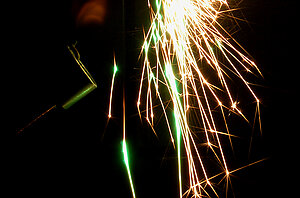March 4, 2020

Researchers from the department of Fiber Optical Sensor Systems at the Fraunhofer Heinrich Hertz Institute HHI, in cooperation with Clausthal University of Technology, have investigated the spark formation of rare earth metals. For the first time, they were able to observe and analyze colored phases of the sparks, which otherwise only occur in flames but not in glowing particles.
In daily life, sparks can be observed on top of wood fires, in metalworking but also when burning sparklers. This hot, solid or liquid matter (so-called blackbody radiators) has a narrow color range, which is limited to dark red (carbon sparks) to yellow gold (iron) and bright white (magnesium, aluminium). While flames can take on any color depending on the element, glowing particles in other colors like green or blue are generally not possible.
In order to be able to produce sparks in other colors, metal particles must burn in the gas phase. On the basis of theoretical considerations, exotic metals were selected which fulfill the conditions for such a gas phase combustion. Using fiber-optic sensors, the sparks of these elements were investigated in a time-resolved manner, revealing an intensely bright green phase in the image of burning erbium particles. These sparks change in flight from surface combustion to gas phase combustion, which is associated with a change in emission from golden blackbody radiation to intense green element-specific emission. Based on this discovery, three other metals were identified that can form color changing sparks. Researchers at the Fraunhofer HHI contributed the basic idea for the experiments, planning and long-time exposure recordings of the sparks and played a major role in understanding the color change, using measurements with fiber-optic systems.
The results were published in the “European Journal of Inorganic Chemistry” (EJIC) and the “Journal of Inorganic and General Chemistry” (“Zeitschrift für allgemeine und analytische Chemie”, ZAAC) and in both cases highlighted with a cover picture. The EJIC and the ZAAC are both peer-reviewed journals, covering topics from the fields of inorganic chemistry and physical-inorganic chemistry, with a focus on pyrotechnical chemistry in the ZAAC. Like the EJIC, ZAAC is also published by Wiley-VCH Verlag.
Further information can be found here .